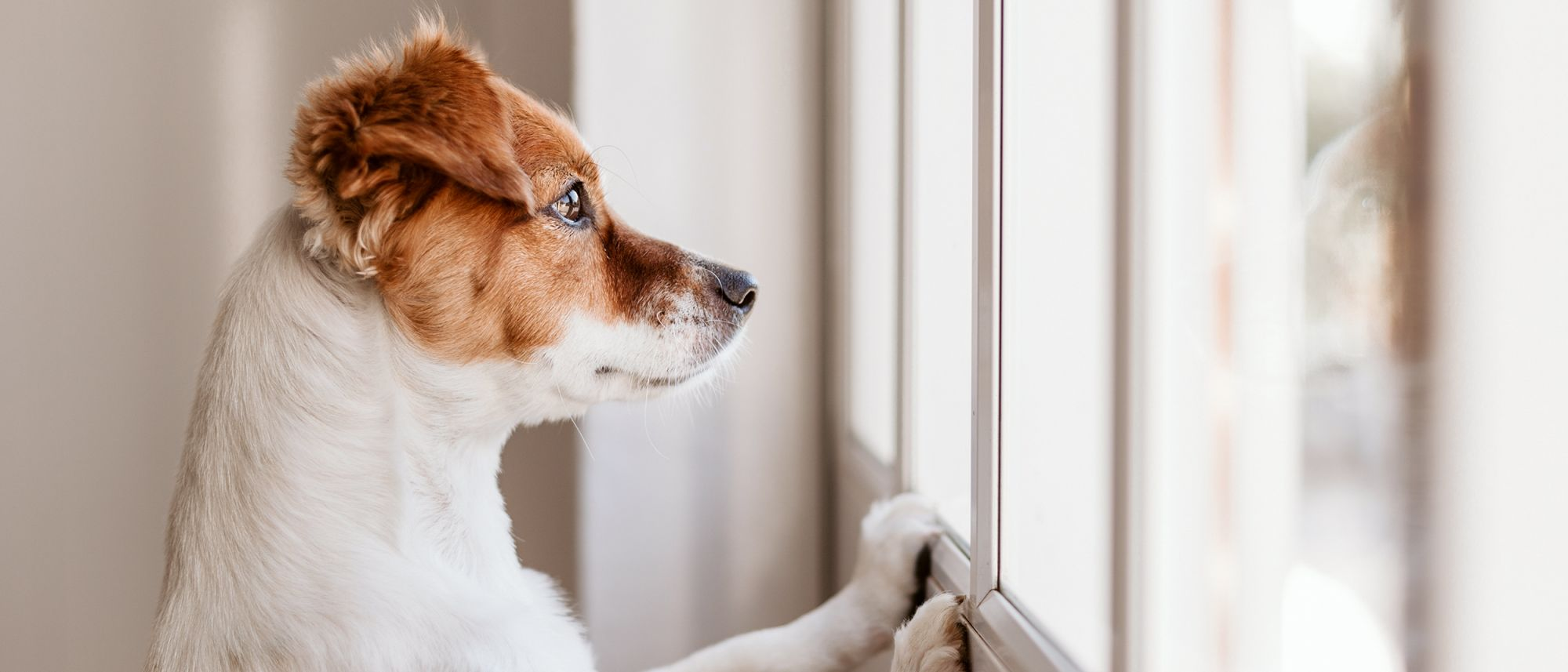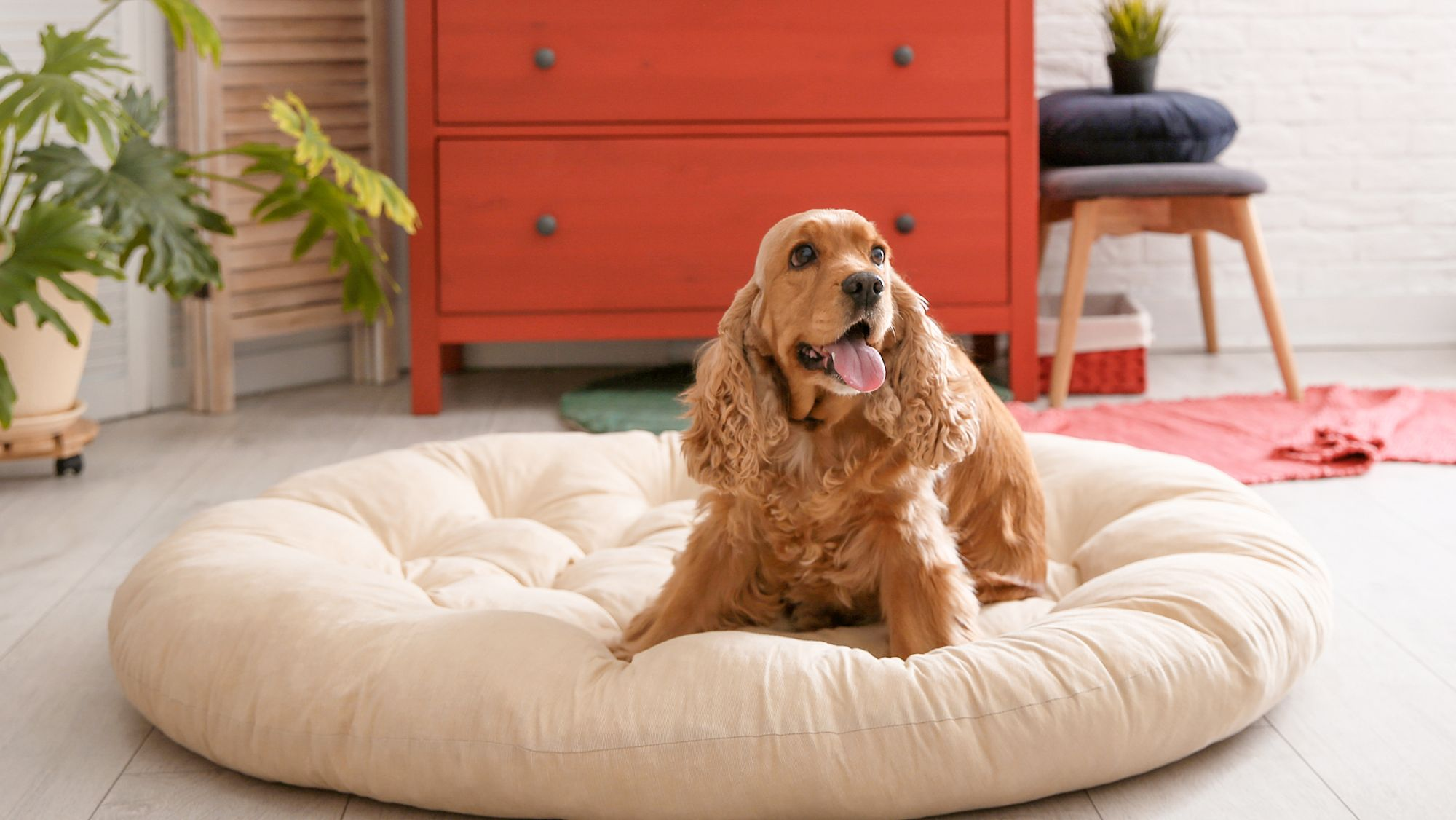Reduce the risk of separation anxiety in dogs after lockdown

If you’ve been spending lots of time at home, your dog’s no doubt enjoyed this time with you. And if you’ve bought a puppy during this period, they’ll only have known your lockdown routine. The challenge comes when your dog needs to start spending more time home alone. Some dogs take changes in their routine and absences from their owners in their stride. But for others, it can bring about separation anxiety, which is distressing for dogs and their owners.
What is separation anxiety?
Separation anxiety is when dogs find it stressful to be apart from the people they’re most attached to. They can become extremely anxious and their distress at this separation can reveal itself in a wide range of behaviours. See below for some of the symptoms to look out for.
Why do dogs develop separation anxiety?
You may think your dog is unlikely to develop separation anxiety, or you may be surprised to notice they’ve suddenly started behaving differently. The difficulty is, there’s a range of factors that can cause separation anxiety in dogs and the main cause can be hard to identify.
Some dogs begin to feel anxious if there’s a sudden change in their life such as moving to a new house or family. Or if they suddenly begin to spend a lot less time with their owners than they’re used to, such as when people return to going out to work after a period of lockdown. Even the loss of another family pet can bring about separation anxiety.
Tempting as it is to enjoy lots of time with our dogs right now, it is important to establish a predictable routine. A consistent routine that allows them to predict what’s going to happen next, will go a long way in reducing stress.
Other contributing factors are more historical. Some dogs who’ve previously suffered from anxiety, for example, are more susceptible to being affected again. So it’s always worth thinking about how any changes in your life or your dog’s life might affect them and make them feel anxious.
Symptoms of separation anxiety in dogs
It’s worth paying close attention to your dog’s behaviour as some signs of separation anxiety can start before you even leave the house. You could also set up a camera to record your dog’s behaviour while you’re away.
Typical signs of separation anxiety in dogs include:

- Following you around your home.
- Trying to leave the house with you when you leave.
- Barking, whimpering or whining when you leave or after you’ve gone.
- Staying close to the door you left through.
- Pacing or unable to rest while you’re away.
- Destructive behaviours, such as chewing or destroying things when they’re alone.
- Reacting to noises when they’re alone that wouldn’t concern them when you’re home.
Other things to look out for, that may seem less connected to separation anxiety but could still indicate your dog is suffering from it, are:
- Loss of appetite.
- House soiling when they're alone, even though they're house trained.
- Panting and drooling.
- Obsessive behaviours such as over-grooming and excessive licking.
Your dog may do some of these things to some extent when you’re at home. But, if they have separation anxiety, these behaviours will become much worse when they’re left alone.
It is critical that a puppy or new dog learns to cope with being left alone. This can be achieved by leaving them for short periods of time to begin with, even in a different part of the home initially.
How to help a dog with separation anxiety
The first step – speak to your vet
If you suspect your dog has separation anxiety, it’s important to tackle it. Not only is it impractical for you to stay at home continually, but it’s also really tough on your dog to suffer in this way.
Also, the signs you’re attributing to separation anxiety may actually be caused by a medical condition. So the first step if you think your dog has separation anxiety is to make an appointment to see your vet.
What to take with you to the vet
Take a list of the kinds of behaviour you’ve noticed that make you think your dog has separation anxiety with details of when this behaviour tends to happen. It will be also useful for your vet if you can take some video footage of the kinds of behaviour your dog’s been showing.
Your vet is likely to ask questions such as:
- How long have you owned your dog?
- Who is usually in your house and when?
- Are the behaviours related to one person leaving or when your dog is totally alone?
- Has your routine changed and, if so, how?
- Have there been other changes such as you moving house?
- Has there been an absence in your home recently?
- Do you have other pets?
- Is your dog from a rescue shelter?
The answers to these questions will help your vet determine whether your dog has separation anxiety or if something else is the problem.
Separation anxiety training for dogs
Prevention is better than cure when it comes to separation anxiety. So let’s look at some of the things you can do now to prepare your dog for when you’re leaving the house more often and for longer periods of time. These approaches may also help if your dog’s already showing signs of separation anxiety.
Create a consistent, predictable routine
If you’re in lockdown or working from home more than usual, it’s tempting to enjoy lots of time with your dog. But establishing a routine that more closely resembles pre-lockdown life, or what your routine is likely to be when restrictions relax, is more beneficial for your dog. A consistent routine enables your dog to predict what will happen next and goes a long way to reducing their stress levels.
Start spending more time apart
The routine you create should include some time for your dog away from you and anyone else in your household. This could be in a different part of the garden, behind a pet gate in a separate room or by leaving them at home when you go out for a short while. It’s important to make sure your dog has everything they need to feel comfortable while you’re away though.
While you are away, make sure to use feeding toys or hide food around the house to help your dog feel comfortable in their home environment and give them something to do.
Leave and arrive quietly
Always keep your hellos and goodbyes low key. When your leaving and homecoming rituals involve minimal fuss, it helps your dog to understand that your absence isn’t anything to worry about. Prolonged goodbyes and hugs at the door may increase their anxiety. While it’s best not to make a big fuss when you first arrive home, do remember to give your dog plenty of attention and affection when you’re together.
Practice at home
While you’re at home more, it’s a good time to practise crate training or teach your dog to go to their bed on command. Also, make sure you reinforce calm behaviours when you’re at home. Next time your dog is relaxing on their bed, for example, praise them for being calm and maybe even take them a tasty chew.
Make sure they stay active
Before your dog has some time alone, make sure they’ve had enough exercise. If they're a little tired then they're more likely to have a nap while you’re away or at least find it easier to relax.

Exercise can help to improve mood and expend pent-up energy. As a side note, exercise has also been linked to higher BDNF in the brain, which may be one of the many reasons why exercise is so beneficial.
Brain-derived neurotrophic factor (BDNF) is a protein present in areas of the brain which is associated with mood, emotion and cognition.
Ask for help
Plan ahead if you’re approaching a time when you’re going to be out of the house more. You can help to manage the transition for your dog by establishing a network of people who can help. Family, friends, dog walkers and day-care centres could help to smooth the change for your dog. Make sure you start using their support before the change in your routine though, so your dog has a chance to get used to them.
How long should you leave your dog alone?
If your dog’s suffering from separation anxiety, or you’ve been spending a lot of time at home with them, you may need to begin with shorter periods of separation. You may also need to start by introducing time alone when you’re still close by – in another room, for example. Once your dog’s comfortable with being left alone, you can gradually extend the length of time you’re away.
If your workplace allows employees to bring pets to the office, this can be useful to limit the amount of time your dog spends at home alone. However, it's important to remember that your dog may still need to have time on their own, so when they can't be brought into the office they're fully prepared for the situation.
Tips for leaving your dog home alone
The following suggestions may help when you start spending more time away from your dog.
Use enrichment activities
Try using feeding toys or hiding food around your house while you’re away. This will give your dog something to do, stimulate their brain and enable them to express their natural behaviours. Start slowly and allow your dog to get used to any feeding puzzles while you’re around before giving them one to use when they’re alone.
Leave your scent
When you leave your dog, make sure they have a quiet comfortable place to rest with a special treat or toy. You could also leave a blanket or piece of clothing carrying your scent with them, as this may help to comfort them.
Leave a TV or radio on
If you leave a TV or radio on or play some music while you’re away, this can also help to soothe your dog. It will make the house feel less quiet in your absence.
Check your dog’s diet
Sometimes, nutrition can help dogs adapt to stressful situations and maintain their emotional balance. Talk to your vet about which diet might be right for your pet. They may suggest Royal Canin’s Canine Calm, which is available only through veterinary recommendation. It’s a dry diet containing nutrients such as milk protein and tryptophan, which are shown to have calming effects on the brain. Or you could try Royal Canin Canine Comfort Care, which is available over the counter in both dry and wet textures and is formulated to help dogs handle stressful circumstances.
Ask an expert
If your dog has separation anxiety, don’t blame yourself and don’t try to deal with it alone. Make sure you contact your vet first if you think there’s a problem. They may then refer you to an animal behaviourist who can give you extra support with specialist guidance. And remember, whichever approach you try, preventing or reducing your dog’s separation anxiety takes a lot of patience and love. So be kind to yourself as well as your dog.
Like & share this page